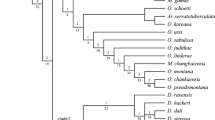Abstract.
To evaluate the sectional classification in Carex, subgenus Carex, the ITS region of 117 species belonging to 32 sections was analyzed with Neighbor Joining (NJ) and Markov chain Monte Carlo (MCMC) methods. In our analyses (1) species of subgenus Indocarex appear as a statistically well supported group within subgenus Carex. (2) The representatives of sections Vesicariae, Hirtae, Pseudocypereae, Ceratocystis, Spirostachyae, Bicolores, Paniceae, Trachychlaenae, Scirpinae, Atratae and Albae group in statistically supported clades with higher support in MCMC than in NJ. (3) C. rariflora clusters with representatives of section Limosae, however only weakly supported. (4) Taxa of section Phacocystis are divided in two statistically supported subclusters that are closely related to a core group of section Hymenochlaenae. (5) Species of sections Montanae, Pachystylae, Digitatae, Phacocystis, Rhomboidales, Careyanae and Frigidae are segregated into two or more clusters each. (6) Five species of section Frigidae cluster together, whereas the seven others are in scattered positions. Based on these results, delimitation of sections is discussed.
Similar content being viewed by others
Author information
Authors and Affiliations
Corresponding author
Rights and permissions
About this article
Cite this article
Hendrichs, M., Oberwinkler, F., Begerow, D. et al. Carex, subgenus Carex (Cyperaceae) – A phylogenetic approach using ITS sequences. Plant Syst. Evol. 246, 89–107 (2004). https://doi.org/10.1007/s00606-004-0128-0
Received:
Published:
Issue Date:
DOI: https://doi.org/10.1007/s00606-004-0128-0




